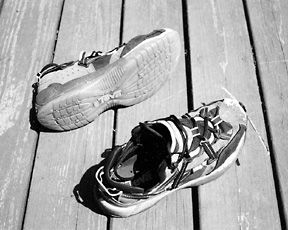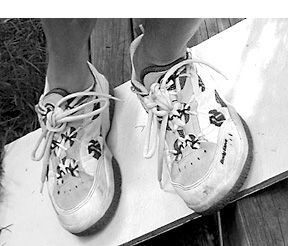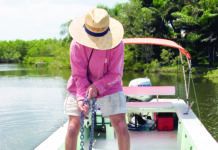
Shoes are important to sailors if for no other reason than they provide foot protection on deck (from such nasties as open cotter pins in rigging turnbuckles), and traction to prevent slipping. A fall can cause injury, and if its over the side…well, potentially fatal.
Shoes can be tough to test, because they involve fashion, and fashion is a subjective thing. Even so, over the years Practical Sailor has tested most major brands of deck shoes. Until about 10 years ago, these were universally the moccasin type-Sperry Top-Siders, Sebago, Timberland, Rockport and a bunch of other companies make similar designs.
Thanks probably to Michael Jordan, the surging popularity of sneaker- or tennis-type shoes infiltrated the marine market and upset the old order. In our May 1, 1990 evaluation, in which we hired a professional lab to measure traction, we rated Harkens H-2000 model tops.
These “engineered” sneaker types were good, even if they were sewn by Malaysian girls living in factory dormitories earning a pittance. An American-made shoe is an even harder find these days.
Since using the lab, we’ve learned that we can develop a fairly accurate picture of traction on our own, by standing on boards covered with various non-skid surfaces-teak decking, patterned gelcoat, polyurethane paint with polymeric granules, and glued-down pads such as Treadmaster. The boards-wet and dry-are inclined between about 35 and 50, with most shoes slipping at somewhere between 40 and 45.
The shoes also are worn for extended periods to see how well they last, and when they fail, where.
Teva Ricochet
We’ve just finished an evaluation of the Ricochet #6638 model from Teva, the company best known for its sandals. We had high hopes for this “Water-friendly Cross Terrainer” because Tevas Spinnaker #6611 model sandal ($84.95), reviewed in the July 1, 2000 issue, is the best sandal weve ever worn on the deck of a boat.
The Ricochet is a high-tech, lightweight shoe. The company calls the single, continuous loop of nylon webbing that wraps the toe and heel “Liquid Frame Technology.” The upper is partly this webbing, reinforced with synthetic nubuck, which looks and feels sort of like leather. The gusseted tongue is a composite of padding and an “airmesh.” The midsole incorporates a “Shoc Pad” for impact absorption. The lacing system is through a series of plastic triangle-shaped pieces riding on short lengths of 1/2″ webbing.
The outsole does not use the narrow, razor siping developed for the Sperry Top-Sider and copied by many others, but widely spaced V-shaped cuts that will last longer but may also pick up sand and small stones. We found traction comparable to most other popular deck shoes.
All in all, this Teva looks like an impressive package-lightweight, cool, well padded, and with good performance on deck.
Unfortunately, during the wear test some of these features slowly evolved into liabilities. The shoe is very well ventilated, so it can dry quickly. When wet, however, your foot gets chilly, at least in New England. In warmer climes, obviously, this would be a feature, not a bug.
We found that the speed lacing system didn’t distribute friction well, so that on tightening the laces most of the pressure is on the top crossing; the result is a somewhat loose fit except at the top, which may pinch.
More importantly, the nubuck at the toe wore more quickly than we expected, followed by separation of the wrap-over-the-toe outsole. This is a tripping hazard, although possibly fixable by a dab of 3M 5200.
While there’s much to admire about this carefully designed shoe, it does have real physical drawbacks. At $89.95, wed give them a pass.
(Teva, PO Box 968, Flagstaff, AZ 86002; 800/367-8382 or 520/779-6004; www.teva.com.)
Two From Body Glove
Body Glove has always made good wetsuits, so we’re glad to see that company taking a crack at marine footwear. As the catalog says, “It’s all about water.”

We’ve been wearing two styles of Body Glove deck shoes for about three months-the Bowline, which is a sneaker-type deck shoe, and the Whitewater, also a sneaker-type, but designed with less synthetic leather and more aggressive drainage for frequent soaking and more amphibious use. The outsoles on both shoes are the “SharkBite” style (shown at right, upper left and right), purported to offer good traction on slick surfaces.
We’ve worn both pairs of shoes for general boatwork, knee-deep boat launching, in cold weather and hot, with and without socks, and even on a deck slick with steering fluid from a leaking Teleflex system. The SharkBite soles have worked well in the real world.
We also tested the shoes on our medium-grit non-skid planks up to 45 angles of tilt, wet and dry, and experienced no slippage. It seems to Practical Sailor that most deck-shoe manufacturers have refined their siping systems, and more importantly the consistency of the rubber in their outsoles, to a high level. By the time you get to a 40 angle of heel on a wet deck, you’d better be looking for something to hold onto with your hand; no sailor would entirely trust a deck shoe in those circumstances.
Both the Bowlines and the Whitewaters have molded synthetic leather toe bumpers that are securely sewn over the uppers. This should eliminate the separation problem we experienced with the Tevas, although time will tell-we haven’t worn the Body Glove shoes as long.
Like the Tevas, the Body Glove Bowlines carry a speed-lacing system that operates partially through plastic eyelets. When these fail, as we suspect they will eventually, the working laces can be rove through bights in the surrounding “Pulley” lacing system.
A minor objection to the Bowlines: The laces are exceedingly long; it takes a full reef knot on top of the finished loops to get the slack off the deck. And a more important gripe about the Whitewaters: When these are worn on bare feet, as they will often be, the interior finish feels rough on top of the toes where the base of the tongue and centerline webbing strap are sewn. There could be a chafing problem if you have far to walk.
The Bowlines sell for $75; the Whitewaters for $65. We think they’re a good value, especially the Bowlines, which combine the support and comfort of a mid-level running shoe with the two most important features for sailors-good non-marking traction and fast drainage.
(Body Glove, 400 Bayview Dr., Manhattan Beach, CA 90266, 310/896-1266; www.bodyglovefootwear.com.)
West Marine Sandals
The jury will always be out on the issue of whether sandals can be proper deck shoes. They’re comfortable, and many offer excellent traction and support. The danger lies in the open design-a line caught between the sole and toes can be a real danger, and sandals offer little in the way of physical or thermal protection for the feet.
This spring we bought a pair of plain blue West Marine-brand sandals with non-marking deck-tread soles. Just for kicks we included them in the wet and dry incline tests of the sneaker-type shoes, and found they had equally good traction and surprisingly good support with the straps cinched up tight. We mention them because at under $30 they represent a good alternative to the expensive sneaker-type shoes in some warm-water circumstances-if you can find them. These sandals seem to have been supplanted at West Marine by the newer, fancier Holo sandals, with a fancier price of $39. The performance characteristics, however, should be similar.
(West Marine, P.O. Box 50070, Watsonville, CA 95077-0070, 800/BOATING; www.westmarine.com.)

































